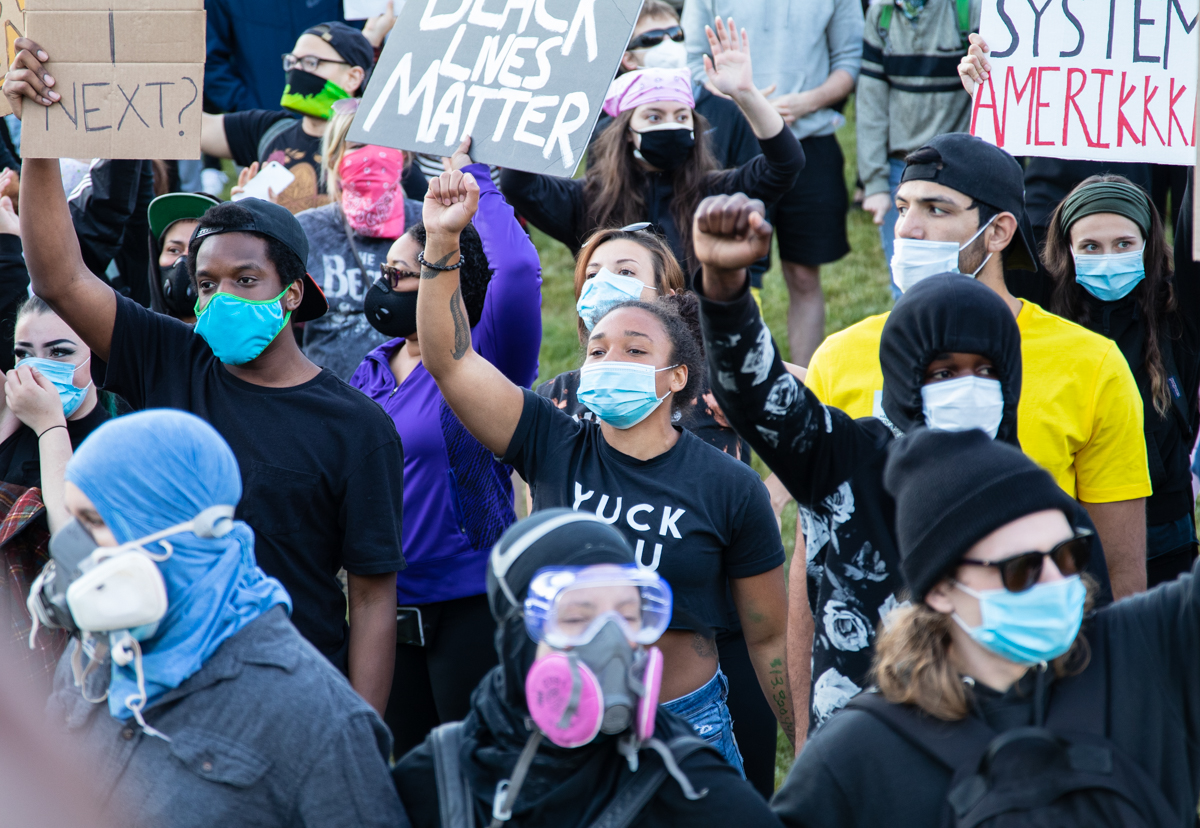Gil Scott-Heron released his most famous recording, “The Revolution Will Not Be Televised,” in 1970. As a spoken-word performance, it’s as electrifying today as it ever was. But if you took the title literally, and said it out loud today, people would laugh in your face.
The revolution will absolutely be televised. The revolution will be on every channel. The revolution will be in every hand. The revolution will be condensed, re-edited, memed and weaponized. The revolution will have multiple angles, freeze-frame, slo-mo and musical accompaniment. The revolution will have color commentary.

Detroit Police briefly detain a Detroit News journalist Sunday. (Photo: Twitter/Branden Hunter)
It didn’t happen overnight, but it sort of did. It takes an event like the unrest of this weekend, itself sparked by a video clip, to make your average news consumer consider what it’s like to take in one’s news in the modern era.
“I was glued to CNN all weekend,” one might hear after a big breaking-news event, but nowadays, why bother? You have to pay for cable and tolerate Don Lemon and Wolf Blitzer. This weekend, you could watch the thing happening live from the comfort of your home with – depending on the photographer’s choices – only the live sound of what was actually happening.
Smartphones have changed our society so much more than we realize. First and most importantly, they’ve allowed us to see the sort of police abuse that leads to George Floyd dying under a cop’s knee. But they’ve also changed the way we see the fallout.
Smaller, lighter, nimbler
Live video used to require a truck with a dish on top, a camera rig of considerable size and a videographer with enough physical strength to drag it around. As cameras got lighter, they could follow reporters through the crowd, but newsgathering still used the old model of reporters and anchors serving as intermediaries, telling viewers what they were seeing and offering analysis, perhaps dragging talking heads into the studio to add to the chatter.
But with smartphones and fast internet connections, the truck is superfluous to any intrepid journalist, or wannabe journalist. Some of the wannabes imitate the current model; they get in front of the camera. But this weekend, the best stayed behind it, and just watched.
The best coverage of this weekend’s unrest in Detroit came from the Detroit dailies, where photographers and reporters deployed their phones and sent the images to viewers via Facebook Live. Over the weekend, both the Free Press and News were live streaming there, along with shorter pieces from reporters and civilians via Twitter. (Deadline Detroit also livestreamed on Facebook.)
It made for riveting ... not television, exactly, but something else. Something better.
The best, hands down, was the Freep, whose editors put Mandi Wright, a seasoned photographer, on the street Friday night. While no skills in focus or composition are really called for in a situation like this, she seemed to know how to look around a scene with a photographer’s eye and a calm that amateurs often lack. She went deep into crowds and kept her narration to a minimum, letting the images tell the story: Here’s someone on roller blades. Here’s someone knocking over outhouses. An angry woman in a hot-pink gas mask. Someone with a leaf blower, sending clouds of tear gas away from demonstrators and back at police.
You heard the obscenities, watched the idiots zooming around on rented scooters. As you-are-there video goes, it was hard to beat.
Smash the gates, trample the fence
“I was floored,” said Tim Kiska, a former Detroit journalist, now a professor at the University of Michigan-Dearborn. “It was real. That’s what struck me. Yes, it was raw, but so fucking what? I got the sense of the temperature of the crowd. Which I really, really liked.”
Here’s the other thing, though: The number of other people doing the same thing? Staggering. Selfie sticks were as plentiful as face masks. And some were using them for exactly that, or FaceTime, or something.

Detroit protest Sunday night (Photo: Michael Lucido)
When home video became ubiquitous, every so often an amateur would capture breaking news. A friend who worked in TV at the time remarked on a helicopter crash caught by two different photographers: “There were multiple angles for the director to choose from,” he marveled. Last weekend, there were probably thousands of angles, each with its own surreal soundscape of shouting, honking and someone yelling GO BACK TO STERLING HEIGHTS, BITCH.
One of the things I’ve always found interesting about the way people communicate is how easily we adapt to new forms. Young people are masters, of course, their plastic brains having been molded by the difference between a text, an email and a phone call, and can parse the nuance of a social-media like or retweet. I expect they will lead us in how we adapt to this new era, of millions of screens, of a cacophony of voices.
But professionalism may yet prevail. Just because you own a tool doesn’t mean you know how to use it.
“Eventually people will gravitate to the best stuff,” said Kiska, who started his own career at the Free Press the same year Gil Scott-Heron dropped his classic. “If something big is happening, if you get people who know what they’re doing, people will find you.”
When I was in journalism school, we talked about the concept of “gatekeepers,” of being the people who decide what goes into the paper and on the newscasts, of the gravity and importance of that role. The gates are gone now, and this isn’t necessarily a bad thing. The gates are gone, the fences are trampled, and what comes next? Who knows? Keep your phone handy.


 by
by








